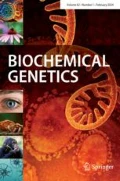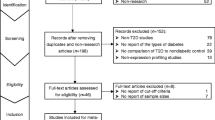Abstract
Resistin is associated with metabolic syndrome and deciphering its developmental and molecular mechanisms may help the development of new treatments. MiRNAs serve as negative regulators in many physiological and pathological processes. Here, miRNA microarrays were used to detect differences in expression between resistin-treated and control mice, and results showed miR-34a to be upregulated by resistin. The purpose of this study was to determine whether miR-34a played a role in resistin-induced decrease of ATP contents. Transient transfection of miR-34a mimics was used to overexpress miR-34a and quantitative RT-PCR was used to detect its expression. Western blot analysis was used to determine the rate of expression at the protein level. ATP content was measured using an ATP assay kit. The target gene of miR-34a was analyzed using bioinformatics and confirmed with dual-luciferase report system. MiR-34a was upregulated by resistin in HepG2 cells, and overexpression of miR-34a was found to diminish ATP levels significantly. This study is the first to show that ATP5S is one of the target genes of miR-34a. Resistin diminishes ATP content through the targeting of ATP5S mRNA 3′UTR by miR-34a.



Similar content being viewed by others
References
Abate N, Sallam HS, Rizzo M, Nikolic D, Obradovic M, Bjelogrlic P, Isenovic ER (2014) Resistin: an inflammatory cytokine Role in cardiovascular diseases, diabetes and the metabolic syndrome. Curr Pharm Des 20(31):4961–4969
Banerjee RR, Rangwala SM, Shapiro JS, Rich AS, Rhoades B, Qi Y, Wang J, Rajala MW, Pocai A, Scherer PE et al (2004) Regulation of fasted blood glucose by resistin. Science 303(5661):1195–1198
Bartel DP (2009) MicroRNAs: target recognition and regulatory functions. Cell 136(2):215–233
Cui Q, Yu Z, Purisima EO, Wang E (2007) MicroRNA regulation and interspecific variation of gene expression. Trends Genet 23(8):372–375
Dang LT, Lawson ND, Fish JE (2013) MicroRNA control of vascular endothelial growth factor signaling output during vascular development. Arterioscler Thromb Vasc Biol 33(2):193–200
Edwards CR, Hindle AK, Latham PS, Fu SW, Brody FJ (2013) Resistin expression correlates with steatohepatitis in morbidly obese patients. Surg Endosc 27(4):1310–1314
Fargnoli JL, Sun Q, Olenczuk D, Qi L, Zhu Y, Hu FB, Mantzoros CS (2010) Resistin is associated with biomarkers of inflammation while total and high-molecular weight adiponectin are associated with biomarkers of inflammation, insulin resistance, and endothelial function. Eur J Endocrinol 162(2):281–288
Greco D, Gambina F, Pisciotta M, Abrignani M, Maggio F (2012) Clinical characteristics and associated comorbidities in diabetic patients with cranial nerve palsies. J Endocrinol Invest 35(2):146–149
Houstek J, Andersson U, Tvrdik P, Nedergaard J, Cannon B (1995) The expression of subunit c correlates with and thus may limit the biosynthesis of the mitochondrial F0F1-ATPase in brown adipose tissue. J Biol Chem 270(13):7689–7694
Jamaluddin MS, Weakley SM, Yao Q, Chen C (2012) Resistin: functional roles and therapeutic considerations for cardiovascular disease. Br J Pharmacol 165(3):622–632
Johnson CD, Esquela-Kerscher A, Stefani G, Byrom M, Kelnar K, Ovcharenko D, Wilson M, Wang X, Shelton J, Shingara J et al (2007) The let-7 microRNA represses cell proliferation pathways in human cells. Cancer Res 67(16):7713–7722
Kim KH, Lee K, Moon YS, Sul HS (2001) A cysteine-rich adipose tissue-specific secretory factor inhibits adipocyte differentiation. J Biol Chem 276(14):11252–11256
Kocamis H, Hossain M, Cinar MU, Salilew-Wondim D, Mohammadi-Sangcheshmeh A, Tesfaye D, Holker M, Schellander K (2013) Expression of microRNA and microRNA processing machinery genes during early quail (Coturnix japonica) embryo development. Poult Sci 92(3):787–797
Kuehbacher A, Urbich C, Dimmeler S (2008) Targeting microRNA expression to regulate angiogenesis. Trends Pharmacol Sci 29(1):12–15
Kuhnert F, Mancuso MR, Hampton J, Stankunas K, Asano T, Chen CZ, Kuo CJ (2008) Attribution of vascular phenotypes of the murine Egfl7 locus to the microRNA miR-126. Development 135(24):3989–3993
Lee SE, Kim HS (2012) Human resistin in cardiovascular disease. J Smooth Muscle Res 48(1):27–35
Li M, Yu M, Liu C, Zhu H, He X, Peng S, Hua J (2013) miR-34c works downstream of p53 leading to dairy goat male germline stem-cell (mGSCs) apoptosis. Cell Prolif 46(2):223–231
Luo Z, Zhang Y, Li F, He J, Ding H, Yan L, Cheng H (2009) Resistin induces insulin resistance by both AMPK-dependent and AMPK-independent mechanisms in HepG2 cells. Endocrine 36(1):60–69
Mallory AC, Vaucheret H (2004) MicroRNAs: something important between the genes. Curr Opin Plant Biol 7(2):120–125
Miko E, Margitai Z, Czimmerer Z, Varkonyi I, Dezso B, Lanyi A, Bacso Z, Scholtz B (2011) miR-126 inhibits proliferation of small cell lung cancer cells by targeting SLC7A5. FEBS Lett 585(8):1191–1196
Muse ED, Feldman DI, Blaha MJ, Dardari ZA, Blumenthal RS, Budoff MJ, Nasir K, Criqui MH, Cushman M, McClelland RL et al (2015) The association of resistin with cardiovascular disease in the multi-ethnic study of atherosclerosis. Atherosclerosis 239(1):101–108
Pirvulescu M, Manduteanu I, Gan AM, Stan D, Simion V, Butoi E, Calin M, Simionescu M (2012) A novel pro-inflammatory mechanism of action of resistin in human endothelial cells: up-regulation of SOCS3 expression through STAT3 activation. Biochem Biophys Res Commun 422(2):321–326
Qi L, Hongjuan H, Ning G, Zhengbin H, Yanjiang X, Tiebo Z, Zhijun H, Qiong W (2013) miR-370 is stage-specifically expressed during mouse embryonic development and regulates Dnmt3a. FEBS Lett 587(6):775–781
Sadashiv ST (2012) Over expression of resistin in adipose tissue of the obese induces insulin resistance. World J Diabetes 3(7):135
Sanadi DR, Pringle M, Kantham L, Hughes JB, Srivastava A (1984) Evidence for the involvement of coupling factor B in the H+ channel of the mitochondrial H+-ATPase. Proc Natl Acad Sci USA 81(5):1371–1374
Savage DB, Sewter CP, Klenk ES, Segal DG, Vidal-Puig A, Considine RV, O’Rahilly S (2001) Resistin/Fizz3 expression in relation to obesity and peroxisome proliferator-activated receptor-gamma action in humans. Diabetes 50(10):2199–2202
Steppan CM, Bailey ST, Bhat S, Brown EJ, Banerjee RR, Wright CM, Patel HR, Ahima RS, Lazar MA (2001) The hormone resistin links obesity to diabetes. Nature 409(6818):307–312
Valsamakis G, McTernan PG, Chetty R, Al Daghri N, Field A, Hanif W, Barnett AH, Kumar S (2004) Modest weight loss and reduction in waist circumference after medical treatment are associated with favorable changes in serum adipocytokines. Metabolism 53(4):430–434
Vendrell J, Broch M, Vilarrasa N, Molina A, Gomez JM, Gutierrez C, Simon I, Soler J, Richart C (2004) Resistin, adiponectin, ghrelin, leptin, and proinflammatory cytokines: relationships in obesity. Obes Res 12(6):962–971
Zhou L, Yu X, Meng Q, Li H, Niu C, Jiang Y, Cai Y, Li M, Li Q, An C et al (2013) Resistin reduces mitochondria and induces hepatic steatosis in mice by the protein kinase C/protein kinase G/p65/PPAR gamma coactivator 1 alpha pathway. Hepatology 57(4):1384–1393
Acknowledgments
This work was supported by the Program of National Natural Science Foundation of China (31301940, 41301051).
Author Contributions
Fengyun Wen and Bi Li contributed to research data, discussion, and preparation of the manuscript and are the guarantors of this work. As such, they had full access to all study data. They take responsibility for the data’s integrity and accuracy. Zhiguo Wei and Haiwei Zhang contributed to cellular experiments. Chunyan Huang, Yingying Zhou, and Jianyu Liu contributed to the study design.
Conflict of interest
No conflicts of interest relevant to this article are exist.
Author information
Authors and Affiliations
Corresponding author
Rights and permissions
About this article
Cite this article
Wen, F., Li, B., Huang, C. et al. MiR-34a is Involved in the Decrease of ATP Contents Induced by Resistin Through Target on ATP5S in HepG2 Cells. Biochem Genet 53, 301–309 (2015). https://doi.org/10.1007/s10528-015-9693-x
Received:
Accepted:
Published:
Issue Date:
DOI: https://doi.org/10.1007/s10528-015-9693-x




